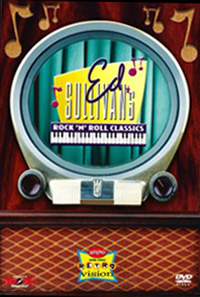Nearly 40 years after Ed Sullivan introduced the Beatles to America on live national television, middle-aged baby boomers who shrieked and swooned over the Fab Four can relive that moment again and again -- and with better reception.
The Beatles' American TV debut in February 1964, ushering in a breathless new era of pop culture months after President Kennedy's assassination, is featured in a newly issued DVD collection of classic rock performances from "The Ed Sullivan Show."
The nine-disc set from Rhino Home Video, titled "Ed Sullivan's Rock 'n Roll Classics," charts the rise of rock 'n' roll, as seen on "Sullivan" from 1955 through 1971, the year the show ended -- from Buddy Holly and Fats Domino to Jefferson Airplane and the Jackson 5.
Large blocks of the collection are devoted to Elvis Presley, the British Invasion, Motown artists (especially the Supremes and the Temptations) and "psychedelic" rockers like Steppenwolf and Vanilla Fudge.
In all, the set captures 144 full-length performances by dozens of acts, packaged with rare footage of Sullivan, trivia tracks, selected discographies and contemporary interviews with artists reminiscing about their experiences on the show.
Sullivan, a newspaper columnist with a famously stiff on-air demeanor but a sharp eye for talent, built a reputation for showcasing artists who were revolutionizing the music scene, although his personal tastes skewed toward more mainstream acts like Frank Sinatra, Ella Fitzgerald and Peggy Lee.
A Leader
While Dick Clark's "American Bandstand" on weekday afternoons was devoted entirely to pop music, the greater prime-time reach of the Sullivan show made it the leading TV venue of choice for up-and-coming recording stars of the day.
"He's left us an amazing archive of pop culture in America, as seen through television for almost a quarter century," said Andrew Solt, who produced the boxed set after obtaining rights to the material from the Sullivan family.
"Sullivan was the place where all the record companies wanted their acts to be," recalled John Moffitt, who joined the show as a production assistant and went on to become director in 1968. "This was prime time, and it was on a Sunday night and everybody was home."
But Moffitt told Reuters in a recent interview that even Sullivan failed to fully grasp the Beatles' surging popularity when they were first booked on his show -- at a then-hefty rate of $15,000 for a total of three appearances.
"Ed was upset, and he said (to talent booker Jack Baab): 'Jack, what were you thinking? It's not the money, Jack. It's who the hell is going to want to see them for three times?' Jack said, 'Ed, trust me. You'll be amazed,"' Moffitt recounted.
"And of course they came over and by ... now all of America knew who they were and were waiting for them to get off that jet."
Besides the Beatles' first appearance, highlights of the set include the Doors' controversial performance of "Light My Fire" that got them banned from the show, and the hip-swiveling Sullivan debut of Elvis Presley in the fall of 1956.
The DVD reveals, contrary to popular recollection, that Elvis was filmed from head to toe his first time out on Sullivan. It was not until his third appearance in January 1957 that cameras shot him only from the waist up.
For the record, Presley's first-ever TV appearance was on Tommy and Jimmy Dorsey's "Stage Show" in January 1956, although he is best remembered for his ratings-shattering introduction on Sullivan.
'We just did the Sullivan Show'
There is also ample footage of the Rolling Stones, much of it in color, showing a younger Mick Jagger singing such hits as "Time Is On My Side" and "Paint It Black." Conspicuously absent, however, is the Stones' January 1967 performance of their hit "Let's Spend the Night Together," in which Jagger grudgingly changed the lyrics to "Let's spend some time together" at the insistence of CBS censors.
By contrast, the Doors' Jim Morrison defied producers later that year by singing the lyrics "girl we couldn't get much higher" despite a promise to alter that phrase with words less suggestive of drug use. The story goes that when furious producers confronted Morrison afterward, telling him the Doors would never do the Sullivan show again, the singer replied: "Who cares? We just did the Sullivan show."
At the other end of the spectrum was the British group Herman's Hermits, whose gentle, fresh-scrubbed stage persona and songs like "Mrs. Brown, You've Got a Lovely Daughter" were more palatable to Sullivan and the network.
"Our songs were sort of allowable to people's mothers," Hermits lead singer Peter Noone said in a taped interview segment, recalling that Sullivan always gave his group an enthusiastic introduction.
Viewers will be struck by the clarity of the sound and picture on the DVDs, especially for the footage shot in color starting in September 1965, compared with the images they remember seeing live on TV.
"Television reception in those days was nothing compared to what it is today," Solt said. "It's not like the average person saw the Rolling Stones at home doing 'Satisfaction' in color in 1965. I didn't have a color TV until '68 or '69."
One difficulty viewers may encounter is the way the material is organized. Two discs contain "chart-toppers" from artists of all stripes arranged chronologically -- from 1965 through 1970 -- by the year they were hits. The rest of the collection is grouped more thematically, such as love songs, dance tunes and music by teen idols.
Presley gets half a volume to himself, as do the Supremes and Temptations. The Beatles figure prominently in the British Invasion and "Legends of Rock" volume, as they should, but they also appear in other categories. The result is some duplication. The collection also lacks liner notes or other guides to help viewers navigate through the material.
Ed Sullivan DVD Set Revisits Golden Age Of Rock
By Steve Gorman, November 20, 2002 | Video